
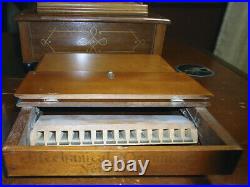
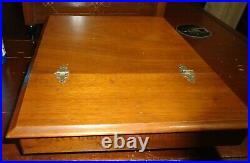

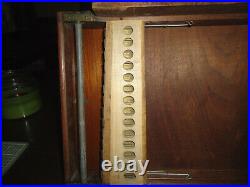
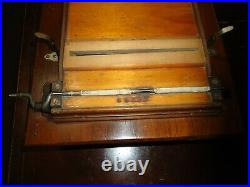
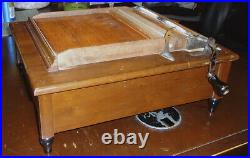
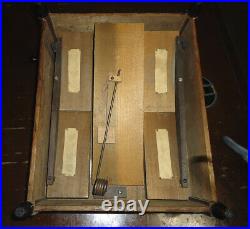
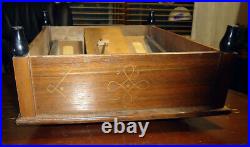
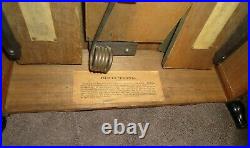
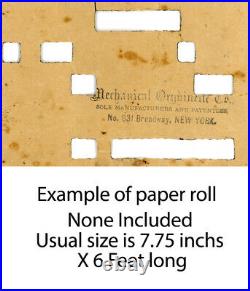
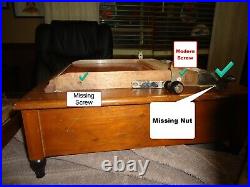

1880 MECHANICAL ORGANETTE CO. NEW YORK REED TYPE ROLLER ORGAN. Serial/Model Number 66333 Stamped inside cover. Patent Date ink stamped in bellows housing. Patented October 12, 1880. Other ink stamping unreadable due to faint inking. Pristine Direction label inside, a little yellow with age no cracks or tears. All intake leathers and bellows are as close to perfect as it gets. All woodworks are original no refinishing. Almost museum quality, Missing handle attachment nut or finial. All springs clean no rust, All intact and in position. 1 screw in interior is not original and 1 smaller screw on same side missing, see Picture with highlights. All other hardware original. White rubber takeup rollers are worn and cracked, on play/advance roller that advances sheet music. Made from Natural toned Mahogany/Oak? With no cracks and no repairs. Black colored turned feet. Has a few small dings and minor scratches due to being over 142 years old. NO SHEET MUSIC ROLLS INCLUDED. No corrosion on brass reeds, all intact. John Wolff’s Web Museum for a restored look and some playable music files from the organ. Sweet Hour of prayer is a good one. The Mechanical Orguinette Company. This detail of the tune sheet above carries the stamp of The Mechanical Orguinette Company of 831 Broadway, New York. This company was formed in 1878 to sell organettes manufactured by the Munroe Organ Reed Company. The Broadway address was in use from 1880. Aeolian later developed the Orchestrelle self-playing reed organ and the Pianola piano-playing mechanism, and went on to become one of the world’s largest music companies. Like many others, it collapsed during the 1930s depression and never fully recovered. A 14-note tune sheet. The idea of storing information as holes in strips of paper has been around for a very long time. Paper tapes and cards have been used as digital storage media in weaving looms in the 1700s, in telegraph machines in the 1800s, in tabulator cards around 1900, and in digital computers in the 1950s and 60s. The organette uses exactly the same principles, except that the information is processed pneumatically rather than mechanically or electrically. This illustration shows the beginning of an original 14-note tune sheet from around 1880. The sheet is 7-3/4 inches wide, and is made from heavy paper (or thin cardboard) about 0.008 thick. The note slots are 9/32″ wide on 17/32″ centres, with a margin of 9/32 at each side. The sheets were produced on automatic perforators which advanced the paper in fixed steps of 1/8. The punches were made slightly longer (9/32″ by 5/32″), so that punching on consecutive steps would cut continuous slots for the longer notes. The music arrangers generally used from 4 to 8 punch steps per quarter note, depending on the tempo and timing requirements for the particular tune. A typical tune sheet is about 6 feet long and plays for about one minute. This hymn tune was joined head-to-tail to form a continuous loop, so that several verses could be sung without a break. There were several major manufacturers of tune sheets, and a thriving industry in “pirate” copies of dubious quality. Note the pencil marks around the edges of the slots, where a previous owner has traced the hole pattern in order to cut a duplicate sheet. “American Orguinette” case decoration. The organette was an expensive instrument in its day, and was often decorated with elegant gold linework in a variety of geometrical patterns. The illustration shows the linework on the lower sides of the “American Orguinette” case. This item is in the category “Collectibles\Decorative Collectibles\Music Boxes”. The seller is “wildthaine” and is located in this country: US. This item can be shipped to United States.
- Original: See listing text
- Flaws: See listing text and Informational marked photo
- Handmade: Yes
- Country/Region of Manufacture: United States
- Brand: MECHANICAL ORGANETTE CO.
- Time Period Manufactured: Pre-1900

